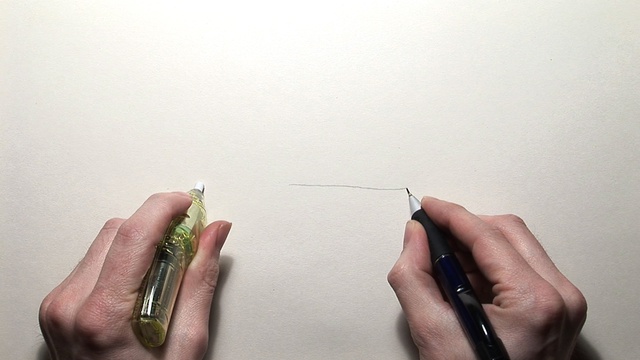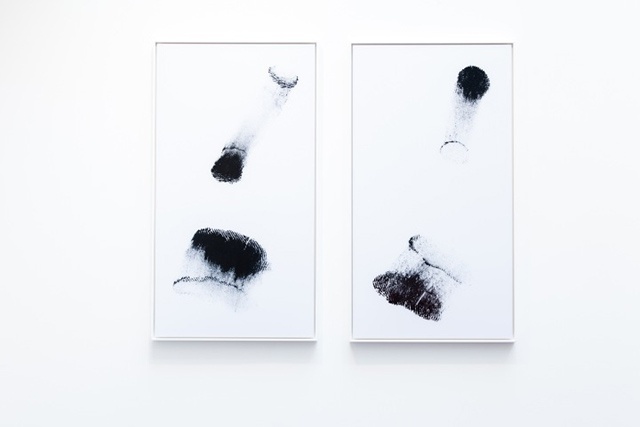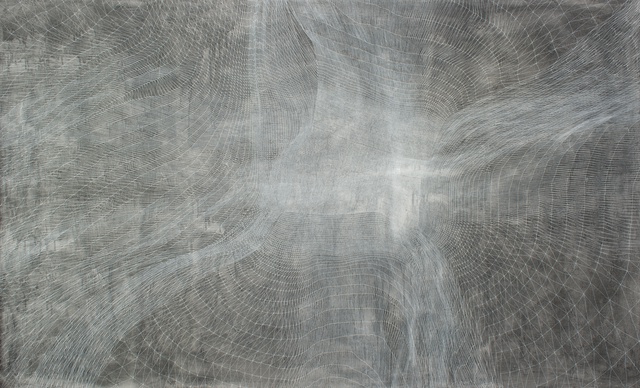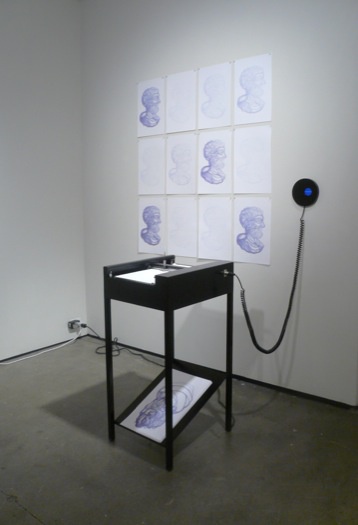1st August – 13th September 2014 Carroll / Fletcher Main Space & Project Space 56 – 57 Eastcastle Street London W1W 8EQ www.carrollfletcher.com
Carroll / Fletcher is to present a group show surveying recent works in expanded drawing which use paper and line as a point of departure. Pencil / Line / Eraser takes its title from a video work by John Wood and Paul Harrison which shows one hand drawing a line while the other hand erases it in the same stroke. The piece epitomises an adherence to process that runs throughout the exhibition, across a broad range of media including drawing, collage, sculpture, video and digital prints.
Pencil / Line / Eraser features work by Julius von Bismarck & Benjamin Maus, Ariel Hassan, Justin Hibbs, AKassen, Christine Sun Kim, Rafael Lozano-Hemmer, Sam Messenger, Manfred Mohr, Diogo Pimentão, Evan Roth, Ignacio Uriarte, and John Wood and Paul Harrison. It is the first exhibition to be presented across both Carroll / Fletcher and Carroll / Fletcher Project Space.
In an expansive vinyl drawing across the front wall of the gallery, Justin Hibbs investigates the construction of space and the process of perception. By acknowledging the artificial nature of spatial depiction, the work actively undermines both depth and perspective by drawing attention to the two-dimensionality of the wall’s surface.
AKassen’s series Flatten image takes its title from a function of the computer re-touching programme Photoshop, which fuses several layers of images into one. Here, the artists take this digital idea and enact it in physical form, where groupings of framed images are condensed into a single object. As a result, the superimposed images often share the same frame and the same framing glass. In three smaller paper works, the artists enact an analogous process of flattening physical objects into paper. A chair, a shovel and a pair of slippers are all transformed, and in some cases leave behind sculptural remnants, metal elements that could not be pulped.
A pioneer of generative and computer art, Manfred Mohr gained access to one of the first computer-driven drawing machines or ‘plotters’ at the Paris Institute of Meteorology in 1969. With this plotter, Mohr developed a series of computer programmes based on certain algorithms that provided a controlled system through which new visual forms could be explored. Random elements were often incorporated to enable new forms to be generated within the framework of the algorithm. In computer technology, Mohr found a means of exploring ideas that went beyond his personal limitations, opening up conceptual realms that might otherwise remain inaccessible.

John Wood and Paul Harrison Pencil/Line/Eraser, 2008 Single channel HDV, 3:50 min
Video works by John Wood and Paul Harrison depict a series of absurd and inventive experiments with drawing. In Photocopier, a photocopier out tray provides the stage for an animated film where each sheet of paper expelled from the machine becomes a new frame of the story. Projected onto a drafting table, 500 Pieces of Paper illustrates the creative process, showing a stack of 500 blank sheets of paper on the left, gradually fill with 500 different ideas on the right.
Diogo Pimentão seeks to explore the limits of drawing, as a sculptural and performative process. For him, the act of drawing involves a kind of choreographic relationship with the body, which determines the scale of the work: from papers mechanically folded by hand to the lacquer of monochrome graphite lines drawn by the body in motion. Correspondingly, the paper surface no longer appears flat but as a flexible plane: a foldable, bendable, sculptural volume.
Ignacio Uriarte draws inspiration from ‘the little creative moments’ within office routines. The two-channel video Blue Ribbon takes as its starting point the simplest of all office doodles: filling out squares on graph paper. Whether monumentalising the ‘cascade’ function in Windows by spacing sheets of paper over a wall, drawing shapes with two different shades of black marker pen, or creating intricate drawings by rapidly typing percentage signs, Uriarte uses administrative tools to restore creative agency to the office worker.

Evan Roth, Zoom In Zoom Out (Multi-Touch Painting series) Lambda print face mounted on acrylic, dibond backing (diptych) 130cm x 120cm Paris, 2013
Across his practice, Evan Roth works to visualise and archive digital culture. His Silhouette series applies the 18th century technique of representing a subject as an outline cut into a single piece of black paper, to the proportions and shape of the Internet. The individual compositions are composed from pieces of the artist’s own Internet browsing data and based on standardised Internet advertising proportions, drawing into question whether these proportions are in reaction to or are a driving force behind the general shape of the web. Displayed alongside are works from his Multi-Touch Painting series, created by performing routine tasks on multi-touch hand held computing devices. Forgetting Spring is a sculpture formed from a 42 metre long print of four months worth of Internet browsing data, compressed using an industrial compactor.
Ariel Hassan’s triangular and hexagonal works are each made from a single sheet of paper that has been cut into 72 individual small units. Each piece is randomly interlocked and fixed to make the final work a unique geometric reconstruction. At the Project Space, Hassan presents a sequence of minutely detailed pencil drawings. Taking inspiration from the universal qualities of music, he describes these works as ‘mash-ups’ from a broad variety of sources, ranging from electroscopic images showing the structures of virus, through to landscape photography. In drawing, Hassan enacts a meditative process, clearing his mind and seeking to allow the work to emerge for itself.

Julius von Bismarck & Benjamin Maus Perpetual Storytelling Apparatus, 2008 Mixed media, apparatus: 90 cm x 120 cm, paper: 61 cm x 5000 cm
Julius von Bismarck & Benjamin Maus’s Perpetual Storytelling Apparatus is a drawing machine, which illustrates a never-ending story by translating the words of a text into patent drawings. It takes seven million patents – linked by over 22 million references – as its vocabulary. New visual connections and narrative layers emerge within the telling of this story through the graphical depiction of technical advancements.

Sam Messenger Veil from Eos, 2013 Ink, pigment and gesso on paper 150 x 242 cm
Sam Messenger’s drawings begin with a series of rules and conditions, which he imposes upon himself in order to fulfil the project. These initial decisions determine how the drawing will progress; yet they can never predict the final outcome. The artistic process is one of physical and temporal surrender to the finished surface of the work, drawing a single white rectangle and then replicating it in increments, building up sections as large as 55 by 55 rectangles in strict correspondence with the Fibonacci sequence. While this rule-based approach to making art connects his method to that of earlier Minimal and Conceptual artists, Messenger delights in the inevitable imperfections of his hand and the unpredictable effects of natural forces.
Christine Sun Kim, who has been deaf since birth, explores the materiality of sound in work that connects sound to drawing, painting, and performance. Her performances are often the starting point for works on paper that display witty evocations of powerful sounds or loaded silences. She is persistently questioning what she calls ‘the ownership of sound’ and highlighting the parameters, social values and sets of rules based around that which is omnipresent and yet invisible to us all.

Rafael Lozano-Hemmer Seismoscopes, 2009 Modified XY Plotter, vibration sensor, ipod, paper, stainless stand Each XY Plotter: 41 x 45 x 17 cm Podium holding computers and electronics:115 x 41 x 45 cm
Rafael Lozano-Hemmer’s Seismoscope device detects vibration around it, from footsteps to tectonic shifts, and records this vibration on paper using an automated XY- plotter. As the Seismoscope registers a seismic wave, it is programmed to draw an illustration of a single 11th Century Sceptical philosopher, over and over again. The actual traces of the drawing follow a random path, while staying within the portrait image that has been burned into the memory of the device, thus each drawing emerges unique.







